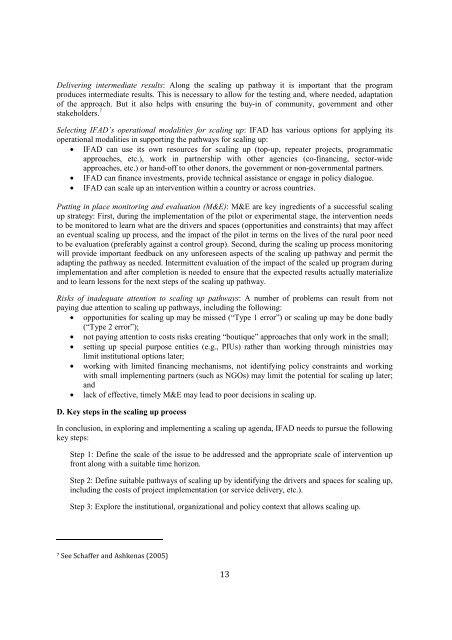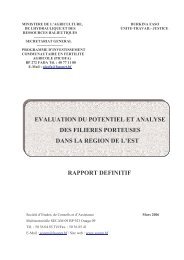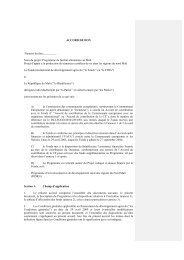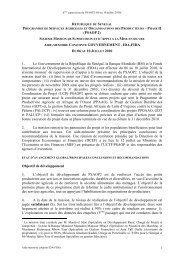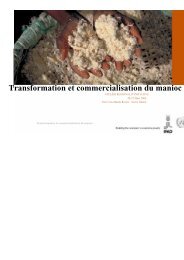Scaling Up the Fight Against Rural Poverty - FIDAfrique
Scaling Up the Fight Against Rural Poverty - FIDAfrique
Scaling Up the Fight Against Rural Poverty - FIDAfrique
Create successful ePaper yourself
Turn your PDF publications into a flip-book with our unique Google optimized e-Paper software.
Delivering intermediate results: Along <strong>the</strong> scaling up pathway it is important that <strong>the</strong> program<br />
produces intermediate results. This is necessary to allow for <strong>the</strong> testing and, where needed, adaptation<br />
of <strong>the</strong> approach. But it also helps with ensuring <strong>the</strong> buy-in of community, government and o<strong>the</strong>r<br />
stakeholders. 7<br />
Selecting IFAD’s operational modalities for scaling up: IFAD has various options for applying its<br />
operational modalities in supporting <strong>the</strong> pathways for scaling up:<br />
• IFAD can use its own resources for scaling up (top-up, repeater projects, programmatic<br />
approaches, etc.), work in partnership with o<strong>the</strong>r agencies (co-financing, sector-wide<br />
approaches, etc.) or hand-off to o<strong>the</strong>r donors, <strong>the</strong> government or non-governmental partners.<br />
• IFAD can finance investments, provide technical assistance or engage in policy dialogue.<br />
• IFAD can scale up an intervention within a country or across countries.<br />
Putting in place monitoring and evaluation (M&E): M&E are key ingredients of a successful scaling<br />
up strategy: First, during <strong>the</strong> implementation of <strong>the</strong> pilot or experimental stage, <strong>the</strong> intervention needs<br />
to be monitored to learn what are <strong>the</strong> drivers and spaces (opportunities and constraints) that may affect<br />
an eventual scaling up process, and <strong>the</strong> impact of <strong>the</strong> pilot in terms on <strong>the</strong> lives of <strong>the</strong> rural poor need<br />
to be evaluation (preferably against a control group). Second, during <strong>the</strong> scaling up process monitoring<br />
will provide important feedback on any unforeseen aspects of <strong>the</strong> scaling up pathway and permit <strong>the</strong><br />
adapting <strong>the</strong> pathway as needed. Intermittent evaluation of <strong>the</strong> impact of <strong>the</strong> scaled up program during<br />
implementation and after completion is needed to ensure that <strong>the</strong> expected results actually materialize<br />
and to learn lessons for <strong>the</strong> next steps of <strong>the</strong> scaling up pathway.<br />
Risks of inadequate attention to scaling up pathways: A number of problems can result from not<br />
paying due attention to scaling up pathways, including <strong>the</strong> following:<br />
• opportunities for scaling up may be missed (“Type 1 error”) or scaling up may be done badly<br />
(“Type 2 error”);<br />
• not paying attention to costs risks creating “boutique” approaches that only work in <strong>the</strong> small;<br />
• setting up special purpose entities (e.g., PIUs) ra<strong>the</strong>r than working through ministries may<br />
limit institutional options later;<br />
• working with limited financing mechanisms, not identifying policy constraints and working<br />
with small implementing partners (such as NGOs) may limit <strong>the</strong> potential for scaling up later;<br />
and<br />
• lack of effective, timely M&E may lead to poor decisions in scaling up.<br />
D. Key steps in <strong>the</strong> scaling up process<br />
In conclusion, in exploring and implementing a scaling up agenda, IFAD needs to pursue <strong>the</strong> following<br />
key steps:<br />
Step 1: Define <strong>the</strong> scale of <strong>the</strong> issue to be addressed and <strong>the</strong> appropriate scale of intervention up<br />
front along with a suitable time horizon.<br />
Step 2: Define suitable pathways of scaling up by identifying <strong>the</strong> drivers and spaces for scaling up,<br />
including <strong>the</strong> costs of project implementation (or service delivery, etc.).<br />
Step 3: Explore <strong>the</strong> institutional, organizational and policy context that allows scaling up.<br />
7 See Schaffer and Ashkenas (2005)<br />
13


